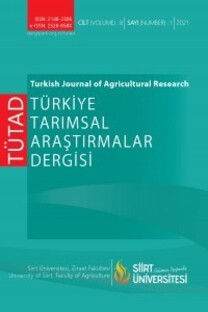Kurak bölgelerde yağmur suları büyük miktarda düzensizdir ve bu sular hızla yüzey akış nedeniyle kaybolur. Su hasadı kurak bölgeler için son derece önemlidir. Kurak alanlarda, su hasadı doğrudan bitki büyüme ve toprak ve su korunması süreci ile ilgilidir. Su hasadı, arazinin bir bölümüne düşen genellikle az ve verimsiz yağmur suyu payını, bir başka bölüm arazisinin payına ekleyerek bu payı iki katına çıkarma ilkesine dayanmaktadır. Bu da ikinci bölge için gerekli sulama suyu miktarını karşılar duruma getirmekte ve böylece ekonomik tarımsal üretime katkıda bulunmaktadır. Kurak alanlarda uygulanan en önemli mikro havza ve çiftlik su toplama sistemleri; kontur sırtlar, yarı dairesel ve trapez setler, küçük çukurlar, küçük akış havzaları, yüzey akış şeritleri, inter-satır sistemleri, meskat ve kontur olan-tezgah teraslardır. Bu çalışmada, öncelikle çiftlik su toplama sistemlerinde ayrıntılı bir inceleme yapılmıştır. İkinci olarak, yüzey akış şeritleriyöntemi ile su hasadının mercimek verimi üzerine etkisini belirlemek amacıyla bir tarla denemesi yapılmıştır. Araştırma, Şanlıurfa Toprak ve Su Araştırma İstasyonu arazisinde yürütülmüştür. Alan, düşük yağış (370 mm yıl-1) ve yüksek buharlaşmaya (2048 mm yıl-1) sahiptir. Konvansiyonel ve yüzey akış şeritleri yöntemi aynı koşullar altında 12x2.8 m parsel üzerinde uygulanmıştır. Araştırma sonucuna göre, kontrol ve yüzey akış şeritleri için saman ve tohum verimi sırasıyla SÜRÜCÜ et al.2663.7 ve 4602 kg ha-1ve 565.5 ve 1160.1 kg ha-1bulunmuştur. Sonuçlar yüzey akış şeritler yönteminin önemli ölçüde mercimeğin saman ve tane verimini arttırdığını göstermektedir. Buna ek olarak, yüzey akış şerit yöntemi su ve ürün verimliliğini teşvik ederek toprak erozyonunu engellemek için önemli bir potansiyele sahip olduğunu kanıtlamıştır
Anahtar Kelimeler:
Mercimek, akış şerit, su hasadı
Effect of Water Harvesting with Runoff Strip Method on Lentil Yield in Şanlıurfa Province
Water harvesting is crucially important for arid regions where the deficits in rainfall are irregular and a greatamount of this water is rapidly lost due to surface runoff. In the arid areas, water harvesting is directly related to process ofplant growth and conservation of soil and water. Water harvesting is based on the principle of preventing a part of the land,which is usually small and non-productive, from getting the share of rain and adding it to the share of another part. Thismakes the amount of water available for the crop area and thereby contributes to economic and agricultural production. Themost important land-based on micro catchments and farm water-harvesting systems in the arid areas are Contour ridges,Semi-circular and trapezoidal bunds, Small pits, Small runoff basins, Run-off strips, Inter-row systems, Meskat, andContour-bench terraces. In this study, firstly, a detailed review on on-farm water-harvesting systems was performed.Secondly, a field experiment was carried out to determine the effect of water harvesting with run-off strip method on lentilyield. The experiment was conducted in Soil and Water Research Station, Şanlıurfa, Turkey. The area had low rainfall (370mm year-1) and high evaporation (2048 mm year-1). Conventional and runoff strip method were applied with tree replicationon plot of 12x2.8 m under the same condition. The straw and seed yields of control and Strip Plots application were 2663.7and 4602 kg ha-1, and 565.5 and 1160.1 kg ha-1 respectively. The results show that the runoff strips method increased strawand grain yield significantly. In addition, recent studies have proved that runoff strip method has the potential to hinder soilerosion by promoting water and crop productivity.
Keywords:
Lentil, runoff strip, water harvesting,
___
- Anonymous, 1976. USDA, Natural Resources Conservation Service. Field Office Technical Guide, Section IV−Practice Standards and Specifications, 342-Critical Area Planting.
- Anonymous, 1994. Water harvesting for improved Li, X.Y., Gong, J.D., Wei, X.H., 2000. In-situ rainwater agricultural production. Water Reports 3, Proceedings of the FAO Expert Consultation, Cairo, Egypt.
- Bilgel, L., Sözbilici, Y., Çetin, Ö., 1997. Red lentil water consumption in harran plain in the GAP region. General Directorate of Rural Services, A.P.K. Department. Ankara, Turkey. (in Turkish)
- Boers, T.M., 1994. Rainwater harvesting in arid and semi-arid zones. PhD. Dissertation Wageningen Agriculture University. The Netherlands.
- Boers, Th.M., Zondervan, K., Ben-Asher, J., 1986. Micro-Catchment-Water-Harvesting (MCWH) for arid zone development. Agricultural Water Management, 12(1-2): 21-39.
- Dillaha, T.A., Reneau, R.B., Mostaghimi, S., Lee, D., 1989. Vegetative filter strips for agricultural nonpoint source pollution control. Transactions of the ASABE, 32(2):491-496.
- Li, X.Y., Gong, J.D., Gao, Q.Z., Li, F.R., 2001. Incorporation of ridge and furrow method of rainfall harvesting with mulching for crop production under semiarid condition. Agric. 50(3):173–183. Water Manag., harvesting and gravel mulch combination for corn production in the dry semi-arid region of China. J. Arid. Environ., 46:371–382.
- Monis, T., İpekçioğlu, Ş., Çıkman, A., Çetiner, İ.H., 2011. Production inputs and costs of some crops grown in the GAP region in 2011. GAP Agricultural Research Institute Publication, Sanlıurfa, Turkey. (in Turkish)
- Oweis, T., Hachum, A., Kijne, J., 1999. Water harvesting and supplemental irrigation for improved water use efficiency in dry areas. SWIM paper no. 7. System-wide Initiative on Water Management, ICARDA and IWMI. International Water Management Institute PO Box 2075, Sri Lanka.
- Oweis, T., Prinz D., Hachum, A., 2001. Water Harvesting: Indigenous Knowledge for the Future of the Drier Environments. ICARDA, Aleppo.
- Stott, D.E., Mohtar, R.H., Steinhardt, G.C., 2001. Selected papers from 10th International Soil Conservation Organization Meeting May 24–29 Purdue University and USDA-ARS National Soil Erosion Research Laboratory. Summerfield, R.J., 1981. Environmental
- adaptation. In WEBBC., HAWTING.C., eds.,
- Lentils, pp. 91–110. Commonwealth Agricultural
- Bureau, Farnham Royal, England.
- ISSN: 2148-2306
- Başlangıç: 2014
- Yayıncı: SİİRT ÜNİVERSİTESİ ZİRAAT FAKÜLTESİ
Sayıdaki Diğer Makaleler
Gülen ÖZYAZICI, Osman ÖZDEMİR, Safiye Pınar ÖZER, Zühal KALCIOĞLU
Van İlinde Kaba Yem Üretim Potansiyeli, Sorunlar ve Çözüm Önerileri
Nizamettin TURAN, Fevzi ALTUNER
Gölgen Bahar ÖZTEKİN, Mehmet ECE
Orhan DENGİZ, İnci DEMİRAĞ TURAN
Antalya'nın Kepez İlçesinde Geleneksel Sera Üretiminin Özellikleri
Uğur GALE, Yüksel TÜZEL, Gölgen Bahar ÖZTEKİN
Orhan DENGİZ, İnci TURAN DEMİRAĞ
Agricultural Meteorological Properties of Aras Basin in Turkey
Abdulkadir SÜRÜCÜ, Meryem GÜNEŞ, Alaaddin YÜKSEL, Ali Rıza DEMİRKIRAN, Selami KAYA
